The Intel 6th Gen Skylake Review: Core i7-6700K and i5-6600K Tested
by Ian Cutress on August 5, 2015 8:00 AM ESTGenerational Tests on the i7-6700K: Gaming Benchmarks on Mid-Range GPUs
Alien: Isolation
If first person survival mixed with horror is your sort of thing, then Alien: Isolation, based off of the Alien franchise, should be an interesting title. Developed by The Creative Assembly and released in October 2014, Alien: Isolation has won numerous awards from Game Of The Year to several top 10s/25s and Best Horror titles, ratcheting up over a million sales by February 2015. Alien: Isolation uses a custom built engine which includes dynamic sound effects and should be fully multi-core enabled.
For low end graphics, we test at 720p with Ultra settings, whereas for mid and high range graphics we bump this up to 1080p, taking the average frame rate as our marker with a scripted version of the built-in benchmark.
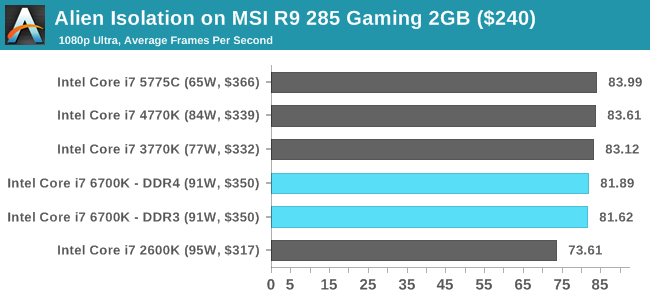
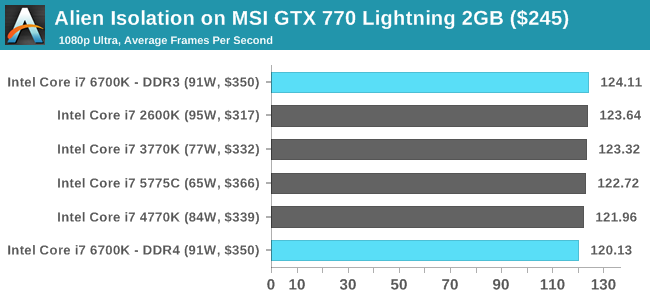
Total War: Attila
The Total War franchise moves on to Attila, another The Creative Assembly development, and is a stand-alone strategy title set in 395AD where the main story line lets the gamer take control of the leader of the Huns in order to conquer parts of the world. Graphically the game can render hundreds/thousands of units on screen at once, all with their individual actions and can put some of the big cards to task.
For low end graphics, we test at 720p with performance settings, recording the average frame rate. With mid and high range graphics, we test at 1080p with the quality setting. In both circumstances, unlimited video memory is enabled and the in-game scripted benchmark is used.
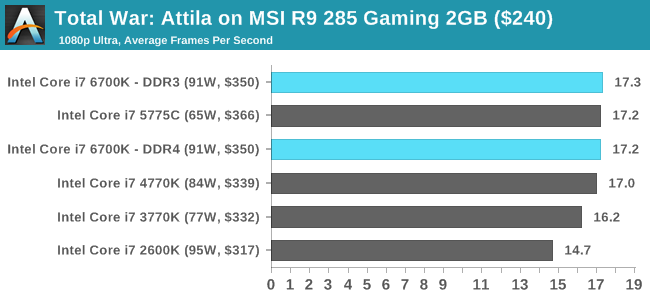
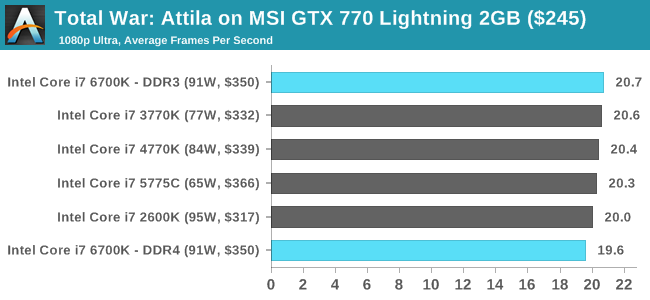
Grand Theft Auto V
The highly anticipated iteration of the Grand Theft Auto franchise finally hit the shelves on April 14th 2015, with both AMD and NVIDIA in tow to help optimize the title. GTA doesn’t provide graphical presets, but opens up the options to users and extends the boundaries by pushing even the hardest systems to the limit using Rockstar’s Advanced Game Engine. Whether the user is flying high in the mountains with long draw distances or dealing with assorted trash in the city, when cranked up to maximum it creates stunning visuals but hard work for both the CPU and the GPU.
For our test we have scripted a version of the in-game benchmark, relying only on the final part which combines a flight scene along with an in-city drive-by followed by a tanker explosion. For low end systems we test at 720p on the lowest settings, whereas mid and high end graphics play at 1080p with very high settings across the board. We record both the average frame rate and the percentage of frames under 60 FPS (16.6ms).
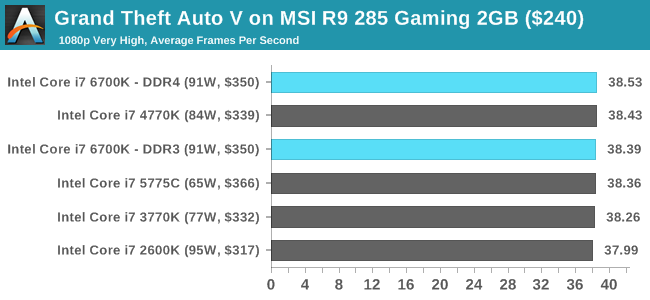
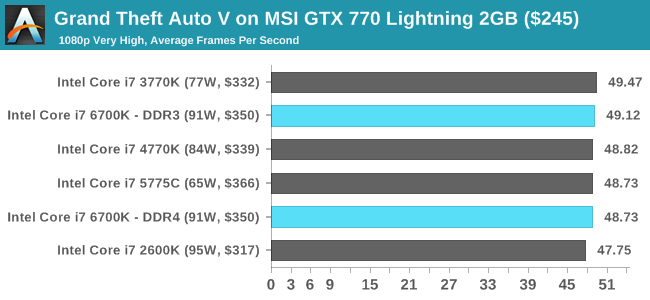
GRID: Autosport
No graphics tests are complete without some input from Codemasters and the EGO engine, which means for this round of testing we point towards GRID: Autosport, the next iteration in the GRID and racing genre. As with our previous racing testing, each update to the engine aims to add in effects, reflections, detail and realism, with Codemasters making ‘authenticity’ a main focal point for this version.
GRID’s benchmark mode is very flexible, and as a result we created a test race using a shortened version of the Red Bull Ring with twelve cars doing two laps. The car is focus starts last and is quite fast, but usually finishes second or third. For low end graphics we test at 1080p medium settings, whereas mid and high end graphics get the full 1080p maximum. Both the average and minimum frame rates are recorded.
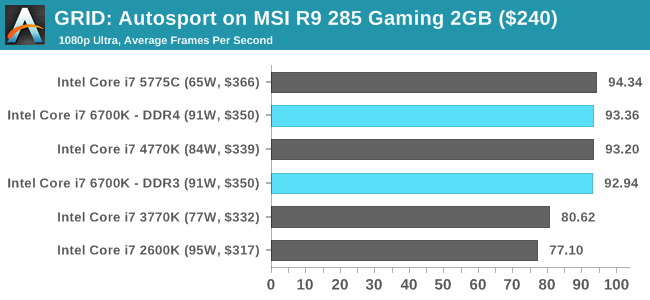
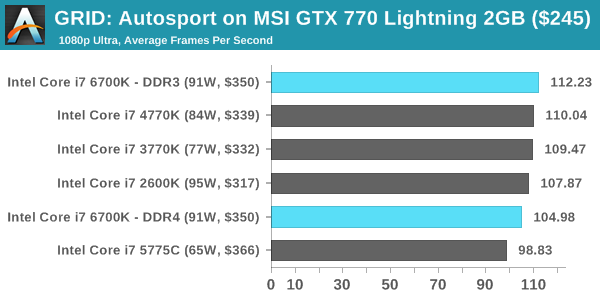
Middle-Earth: Shadow of Mordor
The final title in our testing is another battle of system performance with the open world action-adventure title, Shadow of Mordor. Produced by Monolith using the LithTech Jupiter EX engine and numerous detail add-ons, SoM goes for detail and complexity to a large extent, despite having to be cut down from the original plans. The main story itself was written by the same writer as Red Dead Redemption, and it received Zero Punctuation’s Game of The Year in 2014.
For testing purposes, SoM gives a dynamic screen resolution setting, allowing us to render at high resolutions that are then scaled down to the monitor. As a result, we get several tests using the in-game benchmark. For low end graphics we examine at 720p with low settings, whereas mid and high end graphics get 1080p Ultra. The top graphics test is also redone at 3840x2160, also with Ultra settings, and we also test two cards at 4K where possible.
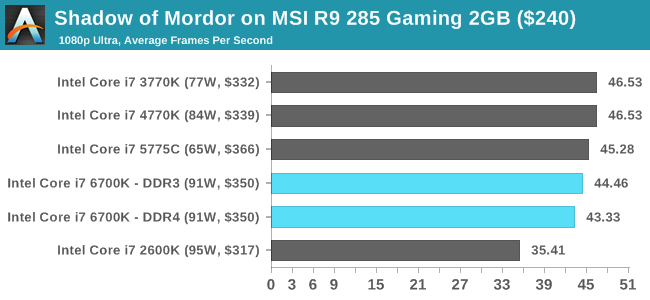
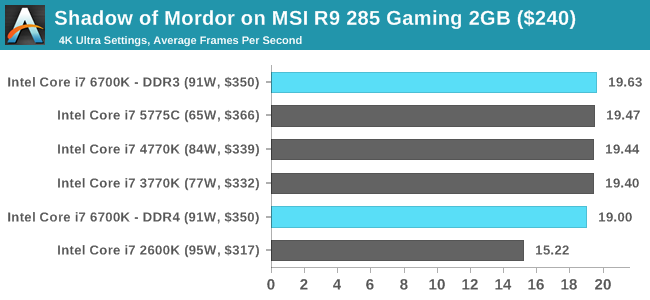

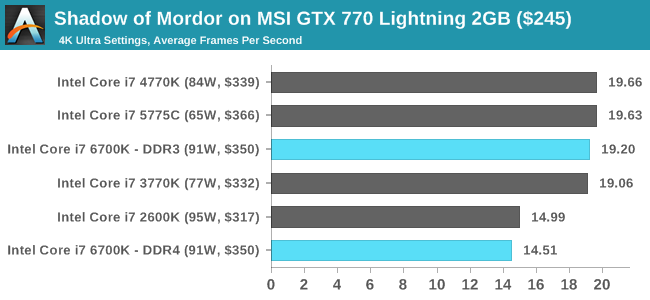















477 Comments
View All Comments
wishgranter - Wednesday, August 5, 2015 - link
Ian, for the overclocking lok here. a better ES samplehttp://www.guru3d.com/articles_pages/core_i7_6700k...
Khenglish - Wednesday, August 5, 2015 - link
It's a shame this doesn't have the 128MB L4 cache. It obviously helps Broadwell over Haswell in CPU benchmarks. If Skylake had it it'd be a clear and very significant upgrade over Haswell, but without it it's just too minor to warrant an upgrade over Haswell or Ivy Bridge.Brazos - Wednesday, August 5, 2015 - link
Is this what happens when AMD stops being a competitor?And I agree with the comments about the IGPU. Most enthusiasts will purchase a graphics card. Save money, space etc by dropping it.
Jumangi - Wednesday, August 5, 2015 - link
Welcome back to the early 2000's when Intel could put out miniscule upgrades while charging premium prices because of the lack of any real competition.A 25% increase over a 4 year old CPU...pathetic.
Gigaplex - Wednesday, August 5, 2015 - link
AMD was very competitive early 2000s.zodiacfml - Thursday, August 6, 2015 - link
Hmm, you kind have a point. Though Intel is relentless with innovation as to chase their dreams on mobile and server market, Skylake architecture seems optimized for server/computing applications. I think it has been that way for many years already. Maybe, the overclocking support Intel is giving to enthusiast is a sign of this. If AMD were competitive, Intel wouldn't have to optimize too much on the server/computing performance.I'm baffled, there's obvious IPC increase and massive improvements in multithreading/Handbrake, but doesn't show in games. With DX12, I doubt it will help.
Eidorian - Wednesday, August 5, 2015 - link
I am frankly looking at Skylake for the platform as a whole. The improvements between generations are not amazing and disconcerting for gaming but I am coming from a Lynnfield + P55 system built in 2009. This is going to be great for me. I can still see users on Sandy Bridge + P67 holding on to those systems a little longer.postem - Wednesday, August 5, 2015 - link
I was reluctant to upgrade to devils canyon, from 950 Bloomfield due to this 6 month proximity to skylake.I never had severe performance issues with the 950 @ 4.2 Ghz, but since i started to use a 980 i saw the frames consistently dropped below.
When i finally updated to 4790K, man it was good. Not only better response on overall processing, better frames, much faster in all aspects.
Bottom line: i dont think you need to upgrade each generation. I would gladly gone to Haswell-E if it wasnt so $$$, but anyway, DC is giving me a hell of performance, and i dont think its worth considering to ugrade it to skylake. It just sucks intel changed the whole socket because of a pin.
If you are comming from a 3-4 generations before, you will really see the benefits from the upgrade i can assure you. I cant say its the end of Sandy Bridge, but its coming to its age.
What really is getting nice is to have good cpus with minimal TDP on laptops. You can have a broadwell i5 with low as 10W consumption.
MrSpadge - Wednesday, August 5, 2015 - link
Ian, could you please undervolt the chips? I know you reported 1.20 v at 4.3 GHz as "undervolting", but that's far more than I'd give even a 32 nm CPU and is just considered low because the stock voltage is so insanely high. Give us a few more data points until about 4.0 GHz, please.Flunk - Wednesday, August 5, 2015 - link
I've got a 2500K overclocked to 4.4Ghz @ 1.2v.